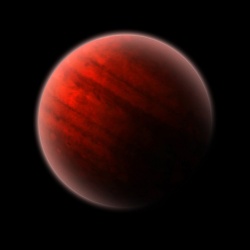
|
| Iblis
|
|
Mid Rim
|
|
Hutt Space
|
|
Cocytus System
|
|
Imperius
|
|
|
|
924 days
|
|
168,000 kilometres
|
|
Not Breathable (Elevated helium and Neon levels)
|
|
600 kilometer per hour winds, clouds of different gases interacting
|
|
4.9125 Standard
|
|
No terrain, gas giant
|
|
Places of interest
|
|
Humanoid tribes
|
|
Species of the Dark Brotherhood
|
|
Basic
|
- Mining Tools
- Foodstuffs
- Water
|
|
|
|
Scholae Palatinae
|
Iblis is a gas giant under the dominion of Scholae Palatinae, residing in the Cocytus System.
History
Iblis is a gas giant in the Cocytus System that emanates a powerful heat from inside due to the incredible gravitational forces within the core. There is very little about the planet itself that is interesting. One outstanding fact is the indefinite auroras that are always visible in the Polar Regions. This occurs because of the planets location in relevance to the sun, and its tilt. Due to these of these factors, the hyper energized particles that the sun give off hit and are absorbed into the magnetic field of the planet, creating these planetary light shows.
Of course, one can only see them from one of the two mining stations in orbit around the planet. These stations are placed in key location within the planet’s thin rings to mine certain ores and fuels. Because of the Iblis’ naturally massive gravitational pull, these stations have repulsor pads in the floor to push the workers away from the planet. This simulates gravity that normal people are used to. A happy, and comfortable miner, is a hard-working miner.
Physical Geography
Lunar
Iblis has eight moons orbiting it at various distances:
Minor Orbitals
Being a gas giant, there is no land mass on the surface. But there the thin rings encircling the planet are home to large asteroids which house mining outposts. There are four in total, two of which have any monetary worth.
Fauzir
Fauzir, is the biggest of the mining asteroids, and therefore houses the biggest of mining outposts. It is approximately six miles in diameter, with the outpost being four and a half miles in diameter. As like most asteroids, it’s completely desolate with no atmosphere. This outpost mainly mines ores like steel and aluminum, along with small pockets of natural gas. It has a population of about a thousand, with most of it being miners, but some are merchants, and the others are Scholae Palatinae guards.
Theron
Theron is the smaller of the duo. It is four miles in diameter housing a mining outpost that entirely covers its surface. It mines mostly ore out of the asteroids, but it also has multiple factories within the complex to work the ore into tools, ships, weapons, or anything of need that can be made of mined ore.
Outlook
Political
Being uninhabitable, Iblis has no political background, except being ruled by the Royal House of Scholae Palatinae.
Military
There is a small paramilitary contingent stationed on the planet's minor orbitals, as well as one squad each from the Expeditionary Force.